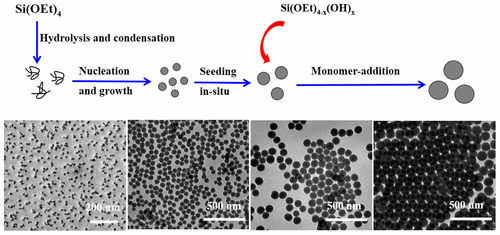Our official English website, www.x-mol.net, welcomes your
feedback! (Note: you will need to create a separate account there.)
Unraveling the Growth Mechanism of Silica Particles in the Stöber Method: In Situ Seeded Growth Model
Langmuir ( IF 3.7 ) Pub Date : 2017-05-17 00:00:00 , DOI: 10.1021/acs.langmuir.7b01140 Yandong Han 1 , Ziyang Lu 2 , Zhaogang Teng 1 , Jinglun Liang 1 , Zilong Guo 1 , Dayang Wang 1, 2 , Ming-Yong Han 3 , Wensheng Yang 1
Langmuir ( IF 3.7 ) Pub Date : 2017-05-17 00:00:00 , DOI: 10.1021/acs.langmuir.7b01140 Yandong Han 1 , Ziyang Lu 2 , Zhaogang Teng 1 , Jinglun Liang 1 , Zilong Guo 1 , Dayang Wang 1, 2 , Ming-Yong Han 3 , Wensheng Yang 1
Affiliation

|
In this work, we investigated the kinetic balance between ammonia-catalyzed hydrolysis of tetraethyl orthosilicate (TEOS) and subsequent condensation over the growth of silica particles in the Stöber method. Our results reveal that, at the initial stage, the reaction is dictated by TEOS hydrolysis to form silanol monomers, which is denoted as pathway I and is responsible for nucleation and growth of small silica particles via condensation of neighboring silanol monomers and siloxane network clusters derived thereafter. Afterward, the reaction is dictated by condensation of newly formed silanol monomers onto the earlier formed silica particles, which is denoted as pathway II and is responsible for the enlargement in size of silica particles. When TEOS hydrolysis is significantly promoted, either at high ammonia concentration (≥0.95 M) or at low ammonia concentration in the presence of LiOH as secondary catalyst, temporal separation of pathways I and II makes the Stöber method reminiscent of in situ seeded growth. This knowledge advance enables us not only to reconcile the most prevailing aggregation-only and monomer-addition models in literature into one consistent framework to interpret the Stöber process but also to grow monodisperse silica particles with sizes in the range 15–230 nm simply but precisely regulated by the ammonia concentration with the aid of LiOH.
中文翻译:

用Stöber方法揭示二氧化硅颗粒的生长机理:原位种子生长模型
在这项工作中,我们研究了Stöber方法中氨催化的原硅酸四乙酯(TEOS)水解与随后的二氧化硅颗粒生长缩合之间的动力学平衡。我们的结果表明,在初始阶段,反应是由TEOS水解决定的,形成硅烷醇单体,称为路径I,并通过相邻硅烷醇单体和衍生的硅氧烷网络团簇的缩合导致小二氧化硅颗粒的成核和生长。之后。之后,反应是由新形成的硅烷醇单体缩合到较早形成的二氧化硅颗粒上所决定的,这被表示为途径II,并导致二氧化硅颗粒尺寸的增大。当在高氨浓度(≥0)下明显促进TEOS水解时。95 M)或在LiOH作为次要催化剂的情况下在低氨浓度下,途径I和II的暂时分离使Stöber方法让人联想到就地播种的生长。这些知识的进步使我们不仅可以将文献中最流行的仅聚集和单体加成模型调和为一个一致的框架来解释Stöber过程,而且可以简单而精确地生长尺寸在15–230 nm范围内的单分散二氧化硅颗粒借助LiOH调节氨气浓度。
更新日期:2017-06-01
中文翻译:

用Stöber方法揭示二氧化硅颗粒的生长机理:原位种子生长模型
在这项工作中,我们研究了Stöber方法中氨催化的原硅酸四乙酯(TEOS)水解与随后的二氧化硅颗粒生长缩合之间的动力学平衡。我们的结果表明,在初始阶段,反应是由TEOS水解决定的,形成硅烷醇单体,称为路径I,并通过相邻硅烷醇单体和衍生的硅氧烷网络团簇的缩合导致小二氧化硅颗粒的成核和生长。之后。之后,反应是由新形成的硅烷醇单体缩合到较早形成的二氧化硅颗粒上所决定的,这被表示为途径II,并导致二氧化硅颗粒尺寸的增大。当在高氨浓度(≥0)下明显促进TEOS水解时。95 M)或在LiOH作为次要催化剂的情况下在低氨浓度下,途径I和II的暂时分离使Stöber方法让人联想到就地播种的生长。这些知识的进步使我们不仅可以将文献中最流行的仅聚集和单体加成模型调和为一个一致的框架来解释Stöber过程,而且可以简单而精确地生长尺寸在15–230 nm范围内的单分散二氧化硅颗粒借助LiOH调节氨气浓度。















































 京公网安备 11010802027423号
京公网安备 11010802027423号